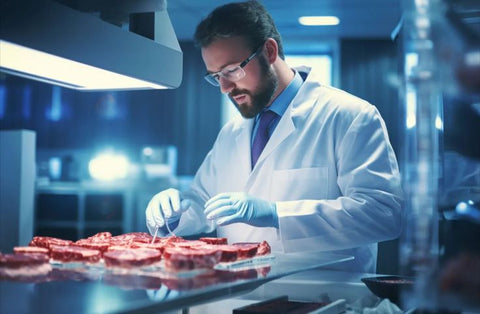
The Future of Food: What Will We Be Eating in 2050?
The way we produce, consume, and think about food undergoes a significant change. With the world population expected to hit 9.7 billion by 2050, the demand for food that is healthy, nutritious, and accessible is growing rapidly. To address this need, the food industry makes strides in areas like lab-grown meat, algae-based proteins, and tailored nutrition plans. These innovations aim to create food systems that are sustainable and flexible.
Why the Shift?
Traditional food production faces big problems. Farming produces about 25% of global greenhouse gases, uses up natural resources, and creates a lot of waste—over 900 million tons every year. At the same time, people around the world face both hunger and excess food consumption. This imbalance shows the need for food that is better for both people and the planet.
Key Innovations Shaping the Future of Food
1. Alternative Proteins
One of the most promising developments is the rise of alternative proteins.
-
Lab-grown meat exemplifies this progress, as real animal meat cultivated from cells in a lab. It removes the need for traditional livestock. Livestock uses 70% of agricultural land and adds to methane emissions. Cultured meat presents a sustainable solution with a smaller ecological footprint. It is already available in Singapore and recently gained regulatory approval in the U.S., with the market expected to reach $25 billion by 2030.
-
Plant-based proteins are another revolutionary development, which uses ingredients like soy and peas to mimic the flavor and texture of animal protein. These alternatives are not only better for the environment—plant-based burgers produce up to 90% fewer greenhouse gas emissions than traditional beef patties—but they also appeal to health-conscious consumers due to their high fiber content and lower cholesterol levels.
-
Algae is a unique food source due to its rapid growth, minimal land and water needs, and ability to absorb carbon dioxide. Rich in nutrients, algae is already used in supplements and plant-based protein products, with potential uses in dairy substitutes and seafood alternatives.
-
Fermentation technologies Fermentation technologies reshape the food landscape by using microorganisms to produce food ingredients like dairy proteins without traditional farming. This approach leads to the creation of animal-free products such as ice cream, cheese, and milk, which reduces resource use.
-
Vertical farming changes agriculture by growing crops in stacked layers within controlled indoor spaces. This method conserves water, eliminates the need for pesticides, and reduces transport distances by placing farms near urban centers. Companies are scaling up production of leafy greens and herbs with vertical farm systems.
- Insects are considered as a protein source due to their high protein content, minimal resource needs, and near-zero greenhouse gas emissions. While insects are a common food source in many cultures, their use in Western markets expands with innovative products like protein bars and flour.
2. Personalized Nutrition
Advances in technology enable personalized nutrition, where diets are customized to individual health needs. By using tools such as AI, genetic insights, and health data, companies can create meal plans tailored to specific goals and conditions. This trend reflects increased consumer awareness of how food affects physical and mental health, with many people recognizing the role of diet in emotional well-being.
3. AI and Automation in Food Systems
Artificial intelligence changes every step of the food supply chain. From precision agriculture that optimizes crop yields to smart kitchens and automated delivery systems, technology improves production, reduces waste, and enhances food access. AI-powered tools also help consumers with meal plans and insights into food safety, which builds a more resilient and responsive food industry.
4. A World Without Food Waste
Approximately one-third of all food produced globally goes to waste, which presents an urgent issue. Innovative solutions, such as upcycle food waste into new products and adopt zero-waste production methods, gain traction. Efforts to conserve water and adopt sustainable farm practices also grow, show the rise of resource-efficient food systems in addressing environmental challenges.
5. Functional Foods and Emotional Wellness
Foods designed to offer health benefits beyond basic nutrition are gaining popularity. Ingredients like probiotics, turmeric, and ashwagandha are being used to create snacks and beverages that support gut health, improve sleep, and reduce stress. This movement toward functional foods expands as consumers seek options that address both physical and emotional well-being.
6. Third-Culture Cuisine
Culinary innovation celebrates global diversity through third-culture cuisine, which combines elements from multiple food traditions. This trend challenges outdated perceptions about ingredients like MSG and emphasizes the cultural richness of fusion flavors. The rise in popularity of these dishes highlights greater appreciation for the shared stories and traditions behind food.
A Resilient Food System
The future of food is being shaped by interconnected priorities: Environmental responsibility, personalization, and technological progress. While breakthroughs like lab-grown meat, algae-based proteins, and precision farm methods offer practical solutions, which achieves global food security and requires a broader shift in how food is valued and consumed. Cutting waste, which uses resource-conscious practices, and accepts dietary diversity are just as important as technological advances.
By 2027, the global food tech market is expected to exceed $342 billion, and reflects not only advancements in production methods but also helps in consumer priorities. As people seek healthier, greener, and more convenient options, these trends are paving the way for a food system that balances human health with environmental responsibility.
Nutri Intact brings you the best of nature with our rich and exotic selection of nuts, spices, edible oils, and more. We preserve nature's goodness so you can enjoy wholesome food in your everyday meals. The best way to appreciate our quality is to try it for yourself. Enjoy the earthy aroma while cooking, feel the improvements in your gut health, and experience the balance that true soul food provides.
We are proud to be an FSSAI-licensed brand (Lic. No: 11224333002597).




